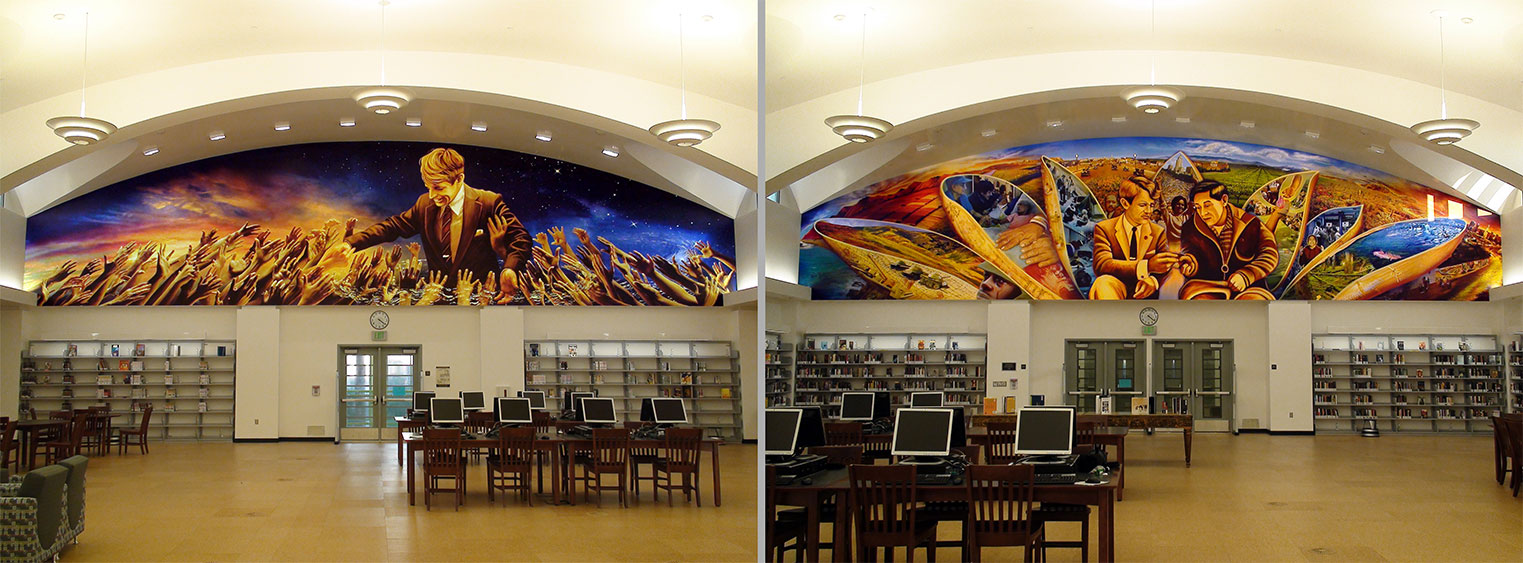On June 5th, 1968 Robert F. Kennedy was shot and assassinated in the food-service pantry next to the ballroom of the Ambassador Hotel after having won the California Primary. The Ambassador Hotel, located on Wilshire Boulevard at mid-city, is being converted into the new RFK LEARNING CENTER for K-12. The school’s media center, formerly the ballroom, will be the sight of Judy Baca’s latest work: a two-mural memorial to RFK, a Senator who was revered as a leader of the ideals of hope and compassion and an advocate for the equality of all people. The two murals will be unveiled in September 2010.

The concept of the panels is that they are a sequential work of art, which can be viewed as one mural or as individual vignettes. I intended for Tiny Ripples of Hope to embody that sense of optimism–and hope–that surrounded Robert Kennedy’s pursuits, and for Seeing Through Other’s Eyes to represent the compassion that was at the of his person. While the mural is to be seen daily by children, it is not strictly a children’s work of art, but a public artwork that is in the tradition of the WPA and the Great Mexican Mural Tradition of the 20th century- works of art that are meant to last for 100’s of years and of the highest quality and can be studied by children for generations to come.
-Judy Baca
Tiny Ripples of Hope
One of the most inspiring moments in his career occurred in Soweto, where he was invited by NUSAS, the anti-Apartheid National Union of South African Students, to deliver its Annual Day of Affirmation Speech during one of South Africa’s darkest year of apartheid. Bobby opened the speech by expressing his “deep interest and affection for a land settled by the Dutch in the mid-seventeenth century, then taken over by the British, and at last independent; a land in which the native inhabitants were at first subdued, but relations with whom remain a problem to this day; a land which defined itself on a hostile frontier; a land which has tamed rich natural resources through the energetic application of modern technology; a land which once imported slaves, and now must struggle to wipe out the last traces of that former bondage.” He was referring to the United States of America. He went on to discuss the oppression of African-Americans in the United States and the plight of war and poverty all over the world, but also, more importantly, he expressed ideals of equality and liberty. He called for the development of an international community and a fight against poverty. He praised compassion.
“Few,” he stated, “will have the greatness to bend history itself: but each of us can work to change a small portion of events, and in the total of all those acts will be written the history of this generation. . . Each time a person stands up for an ideal, or acts to improve the lot of others, or strikes out against injustice, he sends forth a tiny ripple of hope, and crossing each other from a million different centers of energy and daring, these ripples build a current that can sweep down the mightiest walls of oppression and resistance.”
The crowd cheered, lifting their hands toward the visionary. This moment is memorialized in Tiny Ripples of Hope, the first of the two murals that will hang in the media center of the new Robert F. Kennedy Learning Center. Golden hands of hope held up Kennedy into the night sky.
“Take him and cut him out in little stars/And he will make the face of heaven so divine/That all the world will be in love with night/And pay no worship to the garish sun.”
–William Shakespeare
Seeing Through Other’s Eyes
The lotus grows with its roots fastened to the mud, while its beautiful flowers reach eight to twelve inches out of the water to bask in the sunlight. Its pattern of growth signifies the progress of the soul from the primeval mud of materialism, through the waters of experience, and into the bright sunshine of enlightenment. The mud is likened to the roots of evil, namely greed, hatred and delusion, while the blossom stands for enlightenment. Thus, the blooming of these sun-loving flowers is a metaphor for the enlightened being, who emerges undefiled, despite living in a world of mara.
In the second of the two murals, a lotus blossom determines the composition of the mural both formally and conceptually. Each petal represents the most important issues we, as a society, must face, as delineated by Robert F. Kennedy: Environment, Intolerance, Poverty, Education, Health, and War. We see these things through different eyes; the eyes of a child, a polar bear, a senior. At the center of the blossom sit two enlightened men; Kennedy is depicted breaking bread with César Chávez after Chávez’s 36-Day Fast for Life. Oscar Romero, the busboy who cradled Kennedy after he was shot, is depicted to the left of Kennedy. One million people march in the background.
Tiny Ripples of Hope Installation

